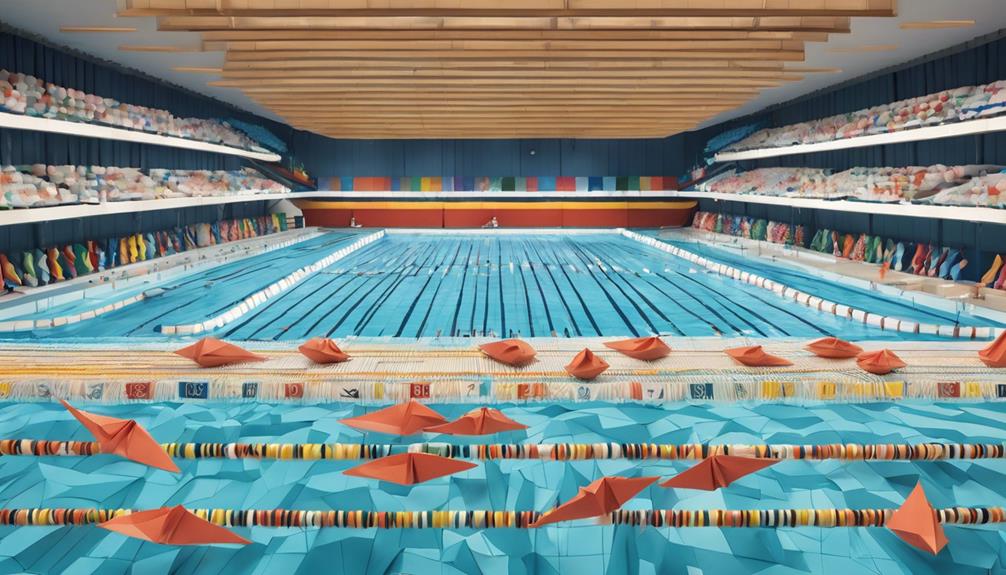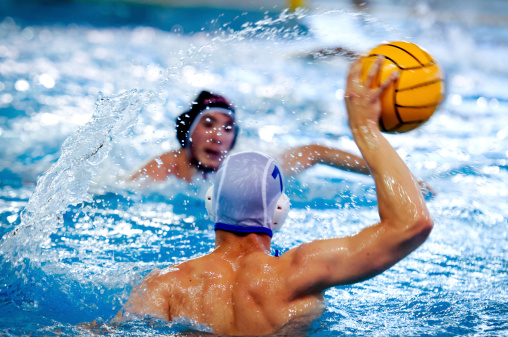General Rules of Finswimming
You're about to plunge into the world of finswimming, where athletes don fin masks, snorkels, and specialized monofins to propel themselves through the water at incredible speeds. To guarantee safety and fairness, competitions take place in pools meeting specific requirements, with equipment meeting safety standards. Athletes are classified by swimming style, speed, and experience, and compete in various race formats and distances. You'll need to master start and turn procedures, meet judging and scoring criteria, and avoid disqualification and penalties. As you explore these general rules, you'll discover the nuances that separate champions from enthusiasts.
Competition Pool Requirements

When competing in finswimming events, you'll need a pool that meets specific requirements, including a minimum length of 25 meters and a minimum width of 10 meters. The pool's dimensions are vital to guarantee a fair and safe competition. In addition to the length and width, the pool's depth is also a pivotal factor. The pool depth should be at least 1.8 meters, but it's recommended to have a depth of 2 meters or more to allow for a safe and comfortable diving experience. Lane marking is another essential aspect of the pool's design. The lanes should be clearly marked with lines and colors to help swimmers navigate the pool and maintain their direction. The lanes should be at least 2.5 meters wide, and the markings should be visible from both above and below the water's surface. By meeting these requirements, you'll be able to host a successful and enjoyable finswimming competition that prioritizes athlete safety and performance.
Equipment and Safety Standards
You'll need a range of specialized gear to participate in finswimming, including masks, snorkels, and, of course, fins, all of which must meet strict safety standards to guarantee a risk-free competition. Your gear will undergo a thorough Gear Inspection to verify it meets the required specifications. This inspection will check for any damage, wear, or malfunction that could compromise your safety or the safety of others.
To further minimize risks, Safety Protocols are in place to address any potential hazards. These protocols outline procedures for emergency situations, such as responding to injuries or equipment failures. You'll be required to familiarize yourself with these protocols and follow them at all times during the competition.
It's essential to understand that safety is paramount in finswimming. You'll be expected to adhere to all safety guidelines and regulations to certify a safe and enjoyable experience for everyone involved. By doing so, you'll be able to focus on your performance, knowing that you're protected by a robust safety framework.
Monofin Specifications and Use

When selecting a monofin, you'll want to ponder the type and material, as they impact performance and durability. You'll also need to verify a proper fit, following monofin sizing guidelines to maximize efficiency and comfort. By understanding these specifications and essentials, you'll be well-equipped to maintain your monofin and optimize its use.
Fin Type and Material
Your choice of monofin type and material substantially impacts your finswimming performance, as different designs and materials cater to various swimming styles, preferences, and aquatic environments. As you explore the world of finswimming, you'll discover that fin aesthetics and evolution have led to a diverse range of options.
When selecting a monofin, consider the following key factors:
- Material: Fins can be made from fiberglass, carbon fiber, or a combination of both. Each material has its unique characteristics, affecting flexibility, durability, and weight.
- Blade shape: The shape of the blade influences the fin's performance, with different shapes suited to various swimming styles and water conditions.
- Flexibility: Fins can be stiff, medium, or soft, impacting your swimming efficiency and comfort.
- Weight: Lighter fins enable faster swimming, while heavier fins provide more power and control.
Monofin Sizing Guidelines
To guarantee a comfortable and efficient finswimming experience, selecting a monofin that fits your foot size and swimming style is vital, as a well-fitting fin can profoundly impact your performance and overall enjoyment. A proper Fin Fit provides a snug, secure fit that allows for peak propulsion and maneuverability in the water. To determine your ideal monofin size, take your Monofin Measurement by tracing the outline of your foot on a piece of paper. Measure the length and width of the tracing to get your foot length and width. Compare these measurements to the manufacturer's sizing chart to find the perfect fit. A well-fitting monofin should allow for a snug heel fit, with your toes extending about 1-2 cm from the fin's edge. Make sure to try on your monofin with your swimsuit and any socks you plan to wear while swimming to guarantee a comfortable, secure fit. By following these guidelines, you'll be able to find a monofin that's tailored to your unique foot shape and swimming style, freeing you to focus on your technique and performance.
Fin Maintenance Essentials
Properly caring for your monofin is essential to extending its lifespan and ensuring peak performance, so you'll want to get into the habit of rinsing it with fresh water after each use. This helps remove chlorine, salt, and other impurities that can damage the fin's materials.
When it comes to fin maintenance, don't skip these essential steps:
- Fin Cleaning: Use a soft-bristled brush to gently scrub away dirt and debris. Avoid using harsh chemicals or abrasive materials that can damage the fin's surface.
- Fin Storage: Store your monofin in a dry, well-ventilated area to prevent moisture buildup. Avoid folding or bending the fin, as this can cause creases and damage.
- Regular Inspection: Regularly inspect your monofin for signs of wear and tear, such as cracks, tears, or loose screws.
- Proper Drying: Dry your monofin thoroughly after cleaning and before storage to prevent water spots and mineral buildup.
Swimmer Classification and Categorization
Finswimmers are categorized into several groups based on their swimming style, speed, and experience, with each classification determining the competition category they'll compete in. As a finswimmer, you'll undergo Athlete Profiling, which involves a thorough assessment of your skills, strengths, and weaknesses. This profiling process helps identify the most suitable competition category for you, ensuring a fair and enjoyable experience.
Within these categories, Disability Categories are also taken into account. Finswimmers with disabilities are classified into specific groups, ensuring they compete against others with similar abilities. This categorization promotes inclusivity and equal opportunities for all athletes, regardless of their abilities.
Race Formats and Distances

As you explore the world of finswimming, you'll encounter various race formats and distances that test athletes' skills and endurance. From the controlled environment of pool events to the unpredictability of open water racing, each format presents unique challenges and requires distinct strategies. You'll learn about the different race formats, including relay competitions, and how they push finswimmers to their limits.
Pool Events Overview
In competitive finswimming, you'll encounter four primary race formats: surface swimming, apnoea, bifins, and immersion, each with its unique set of distances and challenges. As you enter the world of pool events, understanding the nuances of each format is vital for developing an effective event strategy.
Typical distances you'll encounter in pool events are:
- Sprint distances: 25m, 50m, and 100m for surface swimming and apnoea events.
- Middle distances: 200m, 400m, and 800m for surface swimming and bifins events.
- Long distances: 1500m and 4000m for surface swimming events.
- Relay distances: 4x50m, 4x100m, and 4x200m for surface swimming and bifins events.
When competing in pool events, bear in mind the pool design, taking into account factors like lane layout, water temperature, and lighting conditions. By understanding the intricacies of each race format and adapting your event strategy accordingly, you'll be well on your way to achieving success in the world of finswimming.
Open Water Racing
You'll encounter three primary open water race formats: natural lakes or seas, artificial lakes or canals, and coastal swims, each with its unique set of challenges and required skills. As an open water finswimmer, you'll need to adapt to varying water conditions, including tidal impact and ocean currents, which can greatly affect your performance. In natural lakes or seas, you'll face unpredictable water conditions, such as waves, currents, and water temperature fluctuations. Artificial lakes or canals, on the other hand, offer more controlled environments, but may still present challenges like water quality and visibility issues. Coastal swims, with their unique combination of ocean currents and tidal impact, demand exceptional endurance and route-finding skills.
When competing in open water races, you'll need to be prepared for distances ranging from 1 km to 10 km or more, depending on the specific event. You'll need to develop strategies for tackling currents, managing your energy, and staying focused over extended periods. By mastering these skills, you'll be well-equipped to tackle the diverse range of open water racing formats and emerge victorious.
Relay Competitions
Finswimming relay competitions offer a unique dynamic, pitting teams of athletes against each other in a test of speed, endurance, and strategy. As you prepare for a relay competition, you'll need to focus on developing strong team dynamics and effective communication strategies. This is vital, as a single misstep can cost your team valuable seconds.
- Team Roles: Each team member should have a clear understanding of their role and responsibilities within the relay.
- Handoff Strategies: Develop a smooth and efficient handoff process to minimize shift times.
- Pace Management: Work together to maintain a consistent pace throughout the relay, avoiding burnout and optimizing performance.
- Visual Cues: Establish clear visual cues to facilitate communication and coordination during the race.
Start and Turn Procedures
As you prepare to plunge into the pool, proper body positioning and explosive force are essential for an efficient start. Your diving techniques will profoundly impact your overall performance, so it's vital to master the art of diving. Focus on streamlining your body, with your hands together and your arms extended in front of you. This will help reduce drag and allow you to slice through the water with ease. As you propel yourself off the block, aim to enter the water at a 45-degree angle, minimizing splash and turbulence. This will enable you to maintain stroke efficiency, conserving energy for the rest of the swim. During turns, keep your body close to the wall and use your fins to pivot quickly and smoothly. Efficient turns will help you maintain momentum and stay ahead of the competition. By perfecting your start and turn techniques, you'll be able to optimize your performance and achieve your personal best.
Judging and Scoring Criteria

In competitions, judges assess athletes' performances based on execution, technique, and overall presentation, awarding scores that reflect their mastery of the sport. As you prepare for your finswimming competition, understanding the judging and scoring criteria is essential.
Judges consider the following key factors when evaluating your performance:
- Technical Execution: Judges assess your ability to perform the required movements with precision and control.
- Technical Difficulty: The complexity and risk associated with the moves you perform also impact your score.
- Artistic Impression: Judges evaluate your overall presentation, including your style, flair, and showmanship.
- Timing and Synchronization: Your ability to execute moves in harmony with your teammates (if applicable) is also vital.
Fairness debates often arise when scores are disputed, highlighting the importance of impartial judges and accurate scorekeeping. As a competitor, you should be aware of the scorekeeper's role in ensuring the integrity of the competition. By understanding the judging and scoring criteria, you can focus on perfecting your technique and maximizing your score.
Disqualification and Penalty Rules
During competition, you're subject to disqualification or penalty if you fail to adhere to specific rules, regulations, and guidelines. The rules are in place to promote Fair Play and sportsmanship among athletes. Any form of Unsportsmanlike Conduct, including physical or verbal abuse, can result in disqualification. You'll also face penalties for failing to follow safety protocols, such as not wearing required safety gear or ignoring safety signals.
In addition, you may be disqualified for intentionally impeding or obstructing other swimmers, or for intentionally damaging or tampering with equipment. If you're found to have violated these rules, you'll be subject to a penalty, which can range from a warning to disqualification from the competition. The severity of the penalty will depend on the severity of the infraction. Remember, the spirit of Fair Play is essential in finswimming, and any behavior that undermines this principle will not be tolerated. By adhering to the rules and regulations, you can guarantee a safe and enjoyable competition for all athletes.
Protest and Appeal Procedures

You'll need to file a written protest with the competition's referee or jury if you believe a rule has been violated or a mistake has been made during the competition. This written protest should include the details of the incident, the rule allegedly violated, and the remedy sought.
Here are the key steps to follow in the Protest Protocol:
- Submit the protest: File your written protest with the referee or jury within 30 minutes of the incident.
- Investigation: The referee or jury will investigate the incident and gather evidence.
- Decision: The referee or jury will make a decision on the protest, which will be final and binding.
- Appeal Process: If you're unhappy with the decision, you can appeal to the competition's appeal committee.
Frequently Asked Questions
Can I Wear Jewelry While Competing in a Finswimming Event?
As you prepare for your finswimming event, remember that wearing jewelry isn't recommended due to jewelry restrictions, as it poses safety risks, like entanglement or choking hazards, which could compromise your performance and well-being.
How Old Do I Need to Be to Participate in a Finswimming Competition?
Did you know that finswimming is the fastest growing underwater sport, with over 50,000 athletes worldwide? To participate in a finswimming competition, you'll need to meet the age requirements, typically 10-12 years old, as part of youth development programs.
Can I Use Any Type of Swim Cap During a Finswimming Event?
You can't just use any swim cap; it's gotta be made from approved Swim Cap Materials, like silicone or latex, and fit snugly from the options in Cap Sizing Options to minimize drag and maximize your finswimming freedom.
Are Arm Strokes Allowed in Any Finswimming Discipline?
As the saying goes, "rules are meant to be broken," but in finswimming, you'll find arm strokes are strictly prohibited, focusing instead on efficient leg movement and precise stroke techniques that liberate your underwater glide.
Can I Wear a Diving Mask During a Finswimming Competition?
You're wondering if you can wear a diving mask during a finswimming competition? For Mask Safety and superior Underwater Vision, it's allowed, but guarantee it doesn't obstruct your vision or compromise your safety.






